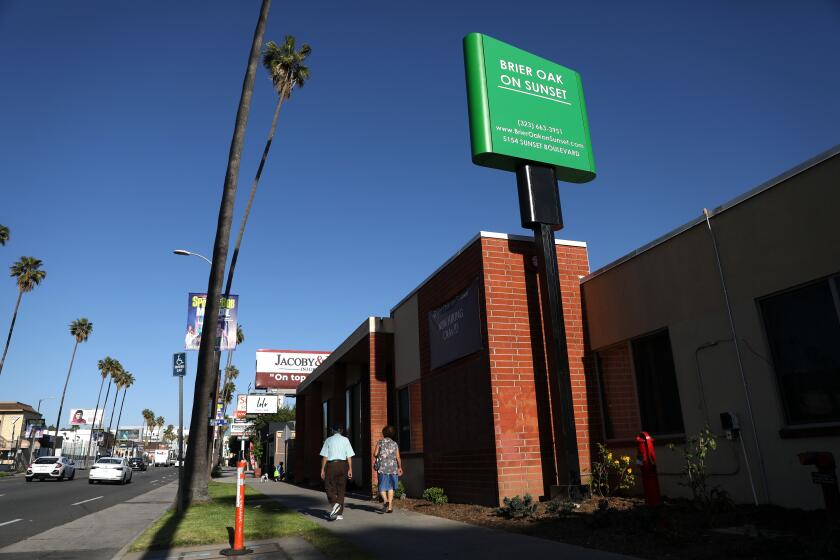Gov. Jerry Brown’s prison program blamed in fatal stabbing
- Share via
The case of a convicted felon who allegedly stabbed a woman to death at a Fontana park-and-ride has exposed flaws in Gov. Jerry Brown’s controversial plan to give local governments responsibility for nonviolent prisoners, San Bernardino County authorities said Tuesday.
David Mulder, 43, a transient with a history of drug-related convictions, was shot and killed Sunday night by a California Highway Patrol officer responding to a report of a woman being attacked in a car near the San Bernardino Freeway. Elisa VanCleve, 49, of Rialto was in the car with Mulder and died of stab wounds.
County probation officials said Mulder was released from state prison Sept. 25 under the governor’s realignment program, which transferred supervision of prisoners and probationers convicted of nonviolent and non-sex-related crimes to local agencies.
Realignment was approved after the U.S. Supreme Court upheld federal oversight of California’s overcrowded prisons. Local law enforcement agencies have complained of being overrun by prisoners and parolees sent to county jails, treatment programs and probation supervision — even with additional state funding.
A week before the killing, another felon released to county supervision under the program allegedly raped a woman in a Fontana motel room, according to the Fontana Police Department. Juan Francisco Aguilera, 30, had convictions for grand theft auto, drug possession, receiving stolen property and robbery.
Fontana Police Chief Rod Jones called both cases prime examples of the failure of realignment.
“Dangerous prisoners that belong in state prison continue to be released early, time and time again, to return to our communities and endanger our families and friends,” Jones said.
A spokesman for the California Department of Corrections and Rehabilitation said blaming realignment for Mulder’s release was misguided and inaccurate. Mulder had finished his prison sentence and would have been released to San Bernardino County, where he was originally sentenced, regardless, agency spokesman Luis Patino said.
“The guy served his prison time and we had no authority to hold him beyond that. Whether he was on parole or probation, he still would have been in their county,” Patino said.
Patino said more than $152 million in state funding has been allocated to San Bernardino County since 2011 to handle the increased responsibilities under prison realignment. Mulder’s early release from county jail after being arrested for a probation violation was responsible for him being on the street Sunday, not state prison realignment, Patino said.
San Bernardino County’s Chief Probation Officer Michelle Scray Brown said that although her agency is equipped to handle the increased caseload under realignment, Mulder was among those prisoners being released who are “simply not appropriate for community supervision.”
Although his crimes were nonviolent, Mulder had been sent to state prison eight times since 1990, primarily for drug possession convictions, but he had a history of violating parole and skirting probation officers.
“We arrested this guy several times for violations,” Probation Officer Brown said. “Clearly, this guy was a high risk to the community.”
After his release from state prison in September, Mulder enrolled in a sober-living facility in Upland. In December, a county probation officer found that Mulder had disappeared and failed to report a change of address. Mulder was arrested March 25. Three days later, a San Bernardino County judge sentenced him to 30 days in county jail for violating the terms of his probation, giving him credit for 11 days already served.
Mulder was released from jail five days later.
San Bernardino County Sheriff’s Department spokeswoman Jodi Miller said Mulder was released from custody April 1 after receiving 14 days of credit for good behavior and work time based on the judge’s sentence.
Chris Condon, a spokesman for the probation agency, said it’s not surprising that Mulder would have been released early because the county jails are filled with inmates who, in previous years, would be in state prison.
“We do not have sufficient bed space to house this population,” Condon said.
For the Record, 10:36 a.m. April 10: An earlier version of this report contained a photo caption with a misattributed quote.
More to Read
Sign up for Essential California
The most important California stories and recommendations in your inbox every morning.
You may occasionally receive promotional content from the Los Angeles Times.














